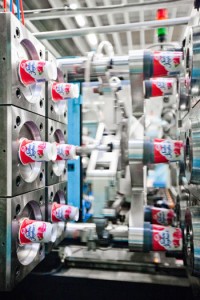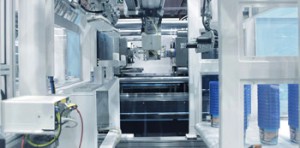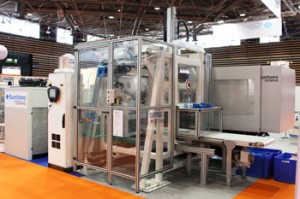Sumitomo Demag makes the case for IM robots
 Many perceived ‘barriers’ to investment and integration in robotics and automation for injection moulding (IM) are based more on misconceptions and out-of-date information than on current realities. Here, Nigel Flowers, managing director at IM machinery supplier Sumitomo (SHI) Demag UK tackles some of those myths, with a focus on packaging moulding markets.
Many perceived ‘barriers’ to investment and integration in robotics and automation for injection moulding (IM) are based more on misconceptions and out-of-date information than on current realities. Here, Nigel Flowers, managing director at IM machinery supplier Sumitomo (SHI) Demag UK tackles some of those myths, with a focus on packaging moulding markets.
Robotic automation in the IM process is no longer the preserve of a few operators with specialist needs. The latest statistics released by the European plastics machinery organisation EUROMAP shows that the number of IM machines sold equipped with robots rose from 18% in 2010 to almost a third (32%) in 2015.
There has been a significant upwards trend. I think part of this has been driven by demand for more flexible solutions, so the use of 6-axis industrial robots is certainly more commonplace today. The price gap between Cartesian and industrial robots has closed markedly, while at the same time, they’ve become easier to programme and simpler to integrate.
For packaging, robotics is primarily used to make customer applications run faster and more cost-effectively. With take-out times of 0.5 seconds or less, it can sometimes be faster to use a robot to remove parts than to let them fall under gravity.
Despite growth both in the number of IM machines fitted with robots and of broader acceptance of their value, questions remain for many in the plastics industry. Let’s address some of those lingering doubts.
1. How do I know the return on investment (ROI) adds up?
The fact that larger numbers of smaller businesses are finding the capital cost of robot-equipped IM machinery more affordable is helping to make ROI calculations easier. Of course, these calculations will be different for every business, but should take into account benefits such as quality improvements, repeatability and extended working hours.
 Being able to operate around the clock inevitably increases productivity and consequently profitability. Also, there is greater awareness that with today’s industrial robots, you’re not just specifying for a single application.
Being able to operate around the clock inevitably increases productivity and consequently profitability. Also, there is greater awareness that with today’s industrial robots, you’re not just specifying for a single application.
Whether it’s three months or three years, whatever the product lifecycle turns out to be, a robot can be reprogrammed to support a different product. Some customers are beginning to switch from Cartesian robots to industrial 6-axis systems, which evidence suggests is connected in part to future-proofing investments.
Applying this thinking to packaging applications, although packaging robots represent a larger investment than robots for slower, more everyday applications, when calculated out, payback is often sooner due to the typical shorter cycle times.
2. Robotics is a ‘black-box’ technology that we will have no control over?
Robotic IM technology has moved on significantly, particularly in relation to adjusting settings and switching between programmes. You no longer need to call in an absolute expert to carry out reprogramming. Control systems have evolved. Although the individual IM operative responsible will still require some form of training, the entire skill set is now within a customer’s own capabilities. However, at a national level, there remains a pressing need to ensure that the next generation of IM engineers are equipped with the necessary skills to fill these in-house roles.
Thanks to computer graphics, at the design stage, it too is easier for customers to be directly involved in scoping out the different options with regard to layout and robot specification. In order to minimise the number of compromises later down the line, we ideally bring the customer and all other partners together at the earliest stage of each project. The earlier decisions about robotics are taken, the better the solution.
3. As a small company is robotic automation appropriate?
For many, the strongest associations when it comes to sophisticated robotics are with large and already highly-automated operations, such as automotive plants. In fact, robotic development is just as rife among smaller-scale manufacturers.
Even packaging converters with just three or four IM machines are seeing the benefits of being able to extend their working hours. If they want to move to longer shifts, they may be looking at the simplest solutions such as Cartesian robots.
As those companies grow, plan for the longer-term and put more emphasis on in-built flexibility, there is always the option of moving to a 6-axis alternative.
4. In mass packaging production, what’s the benefit of incorporating vision systems?
There is a widespread misunderstanding that robots are inseparable from vision systems, and that vision adds another major layer of cost and complexity to the IM operation.
We talk about vision as one of the options with our most sophisticated, quality-conscious installations. Yet, probably under 2% of the systems we sell include vision. Like part weight-checking, vision is only usually required by those very specialist sectors such as automotive components and medical devices where product dimensions and overall specifications have to be precise.
5. I see the benefits for precision markets, but remain unconvinced about robotics in a packaging context
A large percentage of IM containers are destined for the food and beverage sector, and robots can help to minimise the likelihood of contaminants. A robot arm eliminates human contact with the product prior to packing. It also prevents parts picking up any contaminants from the faces of the machine as they fall through.
 The ability to stack parts at the side of the machine means that you have the correct number of components ready to be packed in the box, which in turn speeds up packing and increases output. What’s more, robotics greatly reduce the labour needed to keep the system running 24/7.
The ability to stack parts at the side of the machine means that you have the correct number of components ready to be packed in the box, which in turn speeds up packing and increases output. What’s more, robotics greatly reduce the labour needed to keep the system running 24/7.
Packaging converters may consider investing in robotics to extend their customer offering to in-mould labelling (IML). This adds a whole range of high-quality decorative options, as well as barrier and shelf-life improvements for food, while also handling increasingly thin label materials.
It is also important for customers to realise that the theoretical benefits of a system can be maximised and tailored to suit specific needs at the installation stage.
Commercial advantage is not just about installing this IM machine or that robot. At Sumitomo (SHI) Demag we are focused on optimising customer investments, and continue to develop our application engineering team in order to ensure that ROI is maximised in specific environments such as packaging.
6. How will a robot boost my already flexible plastics workforce?
‘Flexibility’ is an attractive idea, yet for most manufacturers in the packaging arena, consistent performance and consistent quality are the most important criteria. Both can be provided by robotics.
At the same time, the UK cost of labour continues to rise. One operator can look after, say, 10 machines equipped with industrial automation. You can achieve more consistent output while reducing manufacturing costs. Rather than being a jobs taker, there’s strong evidence that adoption of robots across all manufacturing sectors is driving the need for more advanced engineering skills.
There’s little doubt that in terms of flexibility and dexterity, integrating robotics and automation into IM set-ups can increase manufacturing competitiveness. Plastic processors today are rarely considering the injection moulding machine in isolation. There is a definite shift towards integrated production cells, with a need for robotics and peripheral equipment to work seamlessly together.
Until recently, much of the resistance has been tied to cost, expertise and lack of understanding on how a packaging moulder or converter could produce an attractive return on their investment. However, the ability to adapt quickly to the production of new products or variants of existing ones, combined with lower capital costs, makes the business case for investment in robotics stronger than ever.
Visit the Sumitomo Demag website for more information.
See all stories for Sumitomo Demag















